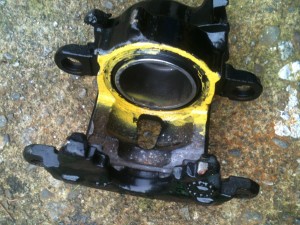The GM Brakes found on third gen Camaro’s are usually front disc and rear drums or both front and rear discs.
This post is going to talk about the general theory of disc brakes, which really comprise of three main components: A caliper, Rotor and a pair of brake pads.
When you step on the brake pedal, pressure from the master cylinder goes to the caliper forcing one or more pistons to squeeze the inner and outer brake pads against the rotor. This creates friction, which slows the vehicle and produces heat. When the brake pedal is released, the caliper loosens its grip, allowing the square cut seals around the pistons to retract the pads slightly. The rotor also helps kick the pads back slightly too.
Many of the advantages of disc brakes can be attributed to the rotor/disc. If you have a ventilated rotor, it draws air through the center of the disc and it is discharged along the outer edge. This is what allows disc brakes to not fade as bad as drum brakes. It dissipates heat. Sometimes you’ll find the splash shield is shaped to channel the flow of air over the exposed rotor surfaces. However, I don’t believe GM originally shaped their splash shields to channel air in through the splash shield from the factory.
I only say this because of an old Hot Rod article from July 1982.
http://www.thirdgen.org/hotrod-shootout-camaro-prep-july1982
You’ll notice on page 33 the caption reads that Dick Guldstrand bent the backing plate to allow for more cooling to the brakes.
Calipers:
There are two basic varieties of calipers: Floating or fixed.
Floating calipers are mounted on slides or bushings that allow the caliper to move sideways when the brakes are applied and released. They typically have a single piston located on the inboard side of the caliper and are used because they are simpler, and less expensive to manufacture than fixed calipers or ones with multiple pistons. The stock GM Brakes used on third gen Camaros are floating calipers. Both the two piston 1LE brakes found mostly in the 88-92 “High Performance” brakes, or the regular “Non-High Performance” disc brakes are floating calipers.
A caliper can contain 1, 2, 4 or 6 pistons. The pistons are relatively large in diameter and short in stroke to provide high pressure on the friction pad assemblies with a minimum of brake fluid displacement. The hydraulics are the same as drum brakes. Press the brakes, the master cylinder pushes the brake fluid into the wheel cylinders and against the wheel pistons in the brakes. GM used “non-high performance” 1 piston delco morraine calipers and starting in 1988 (in only about 4 cars according the thirdgen.org), the 2 piston 1LE “high performance” calipers. The delco morraine calipers were fitted to 10.5″ disc rotors and the “high performance” to 12″ discs (I think it was more like 11.6″ to be exact, but it’s commonly referred to as a 12″ rotor.)
When the brakes are applied on a vehicle with a single piston, floating caliper, the piston moves outward and pushes the inner pad against the rotor. This forces the caliper to slide inward slightly and pull the outer pad up against the rotor. When the pedal is released, the caliper slides out slightly as the pads are kicked away and retract from the rotor. Thus, the caliper is constantly moving in and out as the brakes are applied and released.
Floating calipers like the one found in third gen F-bodies must be free to move if it is going to do its job properly. If the caliper slides or bushings are rusty, worn or damaged, the caliper will not work properly and the pads will wear unevenly. If there is more wear on the inner pad than the outer one, the caliper isn’t sliding. A sticky or frozen caliper may also cause the brakes to drag if the caliper does not slide so the outer pad can kick away from the rotor. This may cause increased wear on the outer pad as well as a steering pull to one side because of the constant drag.
As for rebuilding calipers. With prices so low on the stock rebuilt Delco Morraine GM calipers, I’m almost going to say it’s better to replace your calipers. Although, if you’re on a really tight budget, you should consider rebuilding the front calipers when you change your pads. (The rear calipers I found were difficult to rebuild as they are locking calipers. In my case, it was just cheaper and easier to buy new rear calipers.) If there is no pitting on the bores of the pistons, just take some 600 grit or finer crocus cloth/emery paper and polish it lightly with some brake fluid. Or use a drill powered brake hone. But if you have to increase the diameter of the bore by more than 0.002 inches, replace your calipers. The only reason that rebuilding calipers are recommended is because when you push the pistons back to replace the pads, any dirt or corrosion on the pistons may damage the rubber piston seal in the caliper. As the seal hardens with age, or deteriorates against the constant rubbing of the pistons, there is more of a chance of the seals leaking brake fluid (and thereby failing.)
Here’s a good article on rebuilding calipers from Circle Track magazine. Again, I found it easier to just buy re-manufactured rear calipers, although this method worked O.K on the front calipers for me. I used this article to guide me in rebuilding my gm brakes.
http://www.circletrack.com/chassistech/ctrp_1108_brake_caliper_rebuild/

